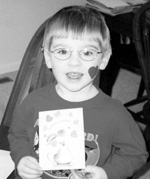 In five short weeks, 4-year-old Andrew's vision in his left eye improved from 20/200 to 20/70, thanks to a thorough screening by the Sight & Hearing Association (SHA) at his preschool and follow-up care by a Twin Cities ophthalmologist.
In five short weeks, 4-year-old Andrew's vision in his left eye improved from 20/200 to 20/70, thanks to a thorough screening by the Sight & Hearing Association (SHA) at his preschool and follow-up care by a Twin Cities ophthalmologist.
Andrew has amblyopia, an eye condition where one eye "sees" significantly different from the other eye. This causes the brain to cease using the weaker eye. In this Burnsville preschooler's case, his right eye sees 20/20, but his left eye, at 20/200, was hardly being used. Amblyopia is an "unseen" eye disease, because no one - not even the most attentive parent - can tell his or her child has it except through a vision test. Indeed, Andrew's parents did not know anything was wrong until the Sight & Hearing Association screened their son.
Shortly before SHA offered vision and hearing screening at his preschool, Andrew had his pre-Kindergarten screening through the school district. During the vision screening, he did not want to cover up his right eye for the screening. (In hindsight, it was because he could only see with his left eye.) The person performing the test dismissed it as Andrew just being "too tired of all the testing." Andrew's mom was told not to be concerned. Two weeks later, when she saw the results of the screening by SHA at his preschool, Child Development and Learning Center (CDLC) in Burnsville, she immediately called Andrew's pediatrician who referred him Dr. Jeffrey Stephens of Eye Physicians and Surgeons in Burnsville.
"Dr. Stephens basically told us that if we would have waited until Andrew was 7- or 8-years-old, he would have been legally blind. Between the Sight & Hearing Association and CDLC, you literally saved my son's eyesight." To treat an amblyopic eye, a patch is commonly used to cover the stronger eye, which forces the weaker eye to work. Glasses are also another corrective tool. In Andrew's case, he is now wearing glasses full time and a patch for four hours a day. Andrew wears the patch over his right eye to force the left eye to work. He'll most likely have to wear the patch until age 10. Andrew has grown accustomed to it, though."We went from coming home from the doctor's office the first day with him saying 'Mom, I can't see you,' to him now being able to see things across the room," explained his mom.
And his glasses? "He loves them. We walked out of the store and he said, 'Mom, everything looks so big!'" Because of his improved vision, Andrew's mom has noticed significant changes in the things Andrew can do, like play on the computer. We have several games, like Thomas the Tank Engine, where fine motor skills are required. He had a difficult time before, but now he can do it all." And, like other 4-year-olds, Andrew continues to play ball, ride his bike like a maniac, create artwork and play with his new puppy.
Andrew's mom is grateful for the screening and her son's improving vision. "Everything you guys do and all that we've learned has just been priceless," she said. "I think everyone should have this [screening] done. I truly am thankful for everything SHA has done for him."